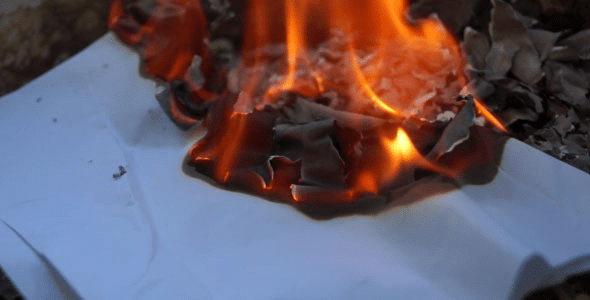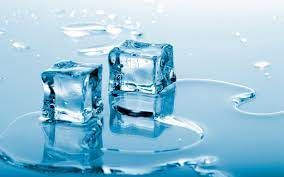Worksheet Solutions: Change Around Us - Class 6 PDF Download
Q1. Write two examples of slow changes:
Germination of seed and ripening of fruits.
Q2. Write two examples of fast changes.
Bursting of crackers and Burning of paper.
Burning Paper is an Irreversible Change
Q3. Is it possible to obtain wood from sawdust?
No, because it is an irreversible change.
Q4. Does the shape of the eraser changes when it is used repetitively?
Yes, the shape of the eraser changes when it is used repetitively.
Q5. Think of some changes that happen in our body.
Growth of nails, growth of hair, increase in height, increase in weight etc.
Q6. A small size boat is made by folding a paper. Can this change be reversed? Think and write one more example of similar type.
Yes, it can be reversed. Another example is a ball made by folding paper.
Q7. Your brother accidentally dropped your favourite pencil box and broke it. This is a change you did not want. Can you reverse this change?
No, this change is not reversible as broken pieces cannot be fixed.
Q8. How candles of different shape are made?
Molten wax is poured into the desired mold and a wick is placed in it. Then it is cooled. This is how we get candles of different shape.
Q9. What is reversible change?
The changes in which we can bring back the products to original form without creating any new substance are known as reversible changes.
Q10. Is cutting down of a tree is reversible change?
No, cutting down of a tree cannot be considered as a reversible change because the same tree cannot be planted again after cutting.
Q11. Is printing of book is a reversible or an irreversible change?
Printing is an irreversible change because ink and paper cannot be separated once printing is done.
Q12. Write two examples each of reversible and irreversible changes.
Reversible Change – melting of ice and stretching of a rubber band.
Irreversible change – Burning of leaves and Souring of milk.Melting of Ice: Reversible Change
Burning Leaves: Irreversible Change
Q13. You made a picture on a blank sheet and coloured it. Can you reverse this change? If not, why?
No, this change cannot be reversed as we cannot get a fresh blank sheet once a picture is drawn and coloured.
Q14. Explosion of a cracker is an irreversible change. How?
Explosion of a cracker is an irreversible change because once crackers are burnt, they cannot be converted back to its original form.
Q15. A bag of cement lying outside in the open got wet due to heavy rain. Can we reverse the change occurred to the cement by placing it under the sun?
No, the change cannot be reversed as it is an irreversible change.
Q16. How iron articles of different shapes and sizes are made?
A piece of iron is heated till it becomes red and hot and then it becomes soft and is beaten into desired shape and size.
Q17. How setting of curd an irreversible change?
Setting of curd is an irreversible change because the new substance (curd) formed cannot be converted back into milk again.
Q18. Is burning of incense stick an irreversible change?
Burning of incense stick is an irreversible change because when incense stick are burnt, new substances are produced in the form of ash and smoke which cannot be converted back into incense stick again.
Burning Incense: Irreversible Change
Q19. Why a candle reduces in size on burning? What kind of change it is?
A candle reduces in size on burning because wax near the wick melts into a liquid and changes into ash and fumes. It is an irreversible change as new substance formed cannot be converted back to candle again.
Q20. Why is metal rim heated before fixing on to wooden cart wheel?
Metals expand on heating and contract on cooling. Iron rims are made slightly smaller than the wheels. Rim is heated so that it expands and lies easily on the wheels. The same rim, on cooling contracts and get firmly fixed on the wheels.
Assertion and Reason Questions
Q1. Assertion (A): Burning of paper is a physical change.
Reason (R): The products formed on burning of paper cannot be easily converted back to paper.
(a) Both A and R are true and R is the correct explanation of A.
(b) Both A and R are true but R is not the correct explanation of A.
(c) A is true but R is false.
(d) A is false but R is true.
Ans. (d)
Q2. Assertion (A): The explosion of a fire crackers is a physical changes.
Reason (R): A physical change is a reversible change.
(a) Both A and R are true and R is the correct explanation of A.
(b) Both A and R are true but R is not the correct explanation of A.
(c) A is true but R is false.
(d) A is false but R is true.
Ans. (d)
Q3. Assertion (A): Respiration is an exothermic process.
Reason (R): In an exothermic process heat is evolved.
(a) Both A and R are true and R is the correct explanation of A.
(b) Both A and R are true but R is not the correct explanation of A.
(c) A is true but R is false.
(d) A is false but R is true.
Ans. (b)
Q4. Assertion (A): The process of conversion of liquid water to its vapours by heating the liquid is called boiling.
Reason (R): The process of conversion of water vapours to liquid by cooling the vapours is called condensation.
(a) Both A and R are true and R is the correct explanation of A.
(b) Both A and R are true but R is not the correct explanation of A.
(c) A is true but R is false.
(d) A is false but R is true.
Ans. (b)
Q5. Assertion (A): The formation of rust is a chemical change.
Reason (R): For the formation of rust iron must be exposed to air and water.
(a) Both A and R are true and R is the correct explanation of A.
(b) Both A and R are true but R is not the correct explanation of A.
(c) A is true but R is false.
(d) A is false but R is true.
Ans. (b)
FAQs on Worksheet Solutions: Change Around Us - Class 6
| 1. What are some common changes in nature that we can observe around us? |  |
| 2. How do humans contribute to changes in the environment? |  |
| 3. What are some examples of changes in technology that have affected our daily lives? |  |
| 4. How do changes in society impact individuals and communities? |  |
| 5. What are some strategies for adapting to changes in our environment and society? |  |























